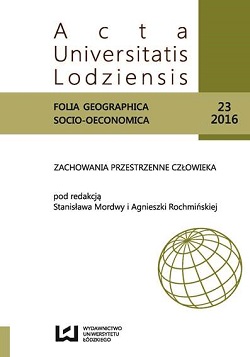Inhabitants of the Łódź region accessibility to shopping malls
DOI:
https://doi.org/10.18778/1508-1117.23.02Keywords:
accessibility, shopping mall, Łódź region, Huff’s model, enhanced two-step floating catchment areaAbstract
The article is focused on examining the availability of inhabitants of the Łódź region to the shopping malls. Field of basic research is the municipality. The analysis included all the municipalities of the Łódź region and the municipalities located beyond, if the customer access to a shop in the Łódź region takes no more than 60 minutes. The same principle was adopted in relation to the shops. The study included all the objects in the Łódź region, and these shops arranged in neighboring regions, to which the inhabitants of the Łódź region are traveling less than an hour. This is to make real results. The data source for the population was the Local Data Bank Central Statistical Office while the database of stores was extracted from the OpenStreetMap resources. The author used the two testing methods to achieve this objective of the survey – Huff’s model and enhanced two-step floating catchment area method.
References
Bieleninik E., Mikuś J., 2005, Prognoza warunkowa zasięgu handlowego rynku, „Badania Operacyjne i Decyzje”, 1, s. 5–24.
Google Scholar
Coleman D.J., Georgiadou Y., Labonte J., 2009, Volunteered Geographic Information: The nature and motivation of producers, „International Journal of Spatial Data Infrastructures Researchˮ, 4(1), s. 332–358.
Google Scholar
Davies R.L., 1977, Marketing Geography, Methuen & Co. Ltd., London.
Google Scholar
Drewiński M., 1992, Geografia handlu, Wydawnictwo Akademii Ekonomicznej, Wrocław.
Google Scholar
Drop P., Gajewski P., Mackiewicz M., 2013, Zastosowanie danych OpenStreetMap oraz wolnego oprogramowania do badań dostępności komunikacyjnej w skali lokalnej, „Acta Universitatis Lodziensis. Folia Geographica Socio-Oekonomicaˮ, 14, Wydawnictwo UŁ, Łódź.
Google Scholar
Fotheringham A.S., O’Kelly M.E., 1989, Spatial Interaction Models: Formulations and Applications, Springer, pp. 224.
Google Scholar
Geronimus A., Bound J,. Neidert L., 1996, On the validity of using census geocode characteristics to proxy individual socioeconomic characteristics, „Journal of the American Statistical Associationˮ, 91(434), s. 529–537.
Google Scholar
DOI: https://doi.org/10.1080/01621459.1996.10476918
Gething P.W., Johnson F.A., Frempong-Ainguah F., Nyarko P., Baschieri A., Aboagye P., Falkingham J., Matthews Z., Atkinson P.M., 2012, Geographical access to care at birth in Ghana: a barrier to safe motherhood, BMC Public Health 2012, 12:991.
Google Scholar
DOI: https://doi.org/10.1186/1471-2458-12-991
Goodchild M.F., 2007, Citizens as voluntary sensors: spatial data infrastructure in the world of Web 2.0, „International Journal of Spatial Data Infrastructures Researchˮ, 2, s. 24–32.
Google Scholar
Haklay M., 2010, How good is volunteered geographical information? A comparative study of OpenStreetMap and ordnance survey datasets, „Environment and Planning Bˮ, 37, s. 682–703.
Google Scholar
DOI: https://doi.org/10.1068/b35097
Haklay M., Weber P., 2008, OpenStreetMap: User-generated street maps, „IEEE Pervasive Computingˮ, 7(4), s. 12–18.
Google Scholar
DOI: https://doi.org/10.1109/MPRV.2008.80
Huff D.L., 1963, A Probability Analysis of Shopping Centre Trade Areas, „Land Economicsˮ, 53, s. 81–89.
Google Scholar
DOI: https://doi.org/10.2307/3144521
Isard W., 1954, Location Theory and Trade Theory: Short-Run Analysis, „Quarterly Journal of Economicsˮ, 68(1), s. 305–322.
Google Scholar
DOI: https://doi.org/10.2307/1884452
Luo W., Qi Y., 2009, An enhanced two-step floating catchment area (E2SFCA) method for measuring spatial accessibility to primary care physicians, „Health and Place”, 15, pp. 1100–1107.
Google Scholar
DOI: https://doi.org/10.1016/j.healthplace.2009.06.002
Mynarski S., 2001, Badania rynkowe w przedsiębiorstwie, Wydawnictwo Akademii Ekonomicznej, Kraków.
Google Scholar
Neis P., Zielstra D., Zipf A., 2012, The street network evolution of crowdsourced maps: OpenStreetMap in Germany 2007–2011, „Future Internetˮ, 4(1), s. 1–21.
Google Scholar
DOI: https://doi.org/10.3390/fi4010001
Rochmińska A., 2013, Atrakcyjność łódzkich centrów handlowych oraz zachowania nabywcze i przestrzenne ich klientów, Wydawnictwo UŁ, Łódź.
Google Scholar
DOI: https://doi.org/10.18778/7525-865-3
Rosik P., 2012, Dostępność lądowa przestrzeni Polski w wymiarze europejskim, „Prace Geograficzne”, 233, IGiPZ PAN, Warszawa.
Google Scholar
Schuurman N., Bérubé M., Crooks V.A., 2010, Measuring potential spatial access to primary health care physicians using a modified gravity model, „Canadian Geographer/Le Géographe Canadienˮ, 54 s. 29–45.
Google Scholar
DOI: https://doi.org/10.1111/j.1541-0064.2009.00301.x
Taylor Z., 1997, Dostępność miejsc pracy, nauki i usług w obszarach wiejskich jako przedmiot badań geografii społeczno-ekonomicznej – próba analizy krytycznej, „Przegląd Geograficznyˮ, 69(3–4), s. 261–283.
Google Scholar
Downloads
Published
How to Cite
Issue
Section
License

This work is licensed under a Creative Commons Attribution-NonCommercial-NoDerivatives 4.0 International License.








